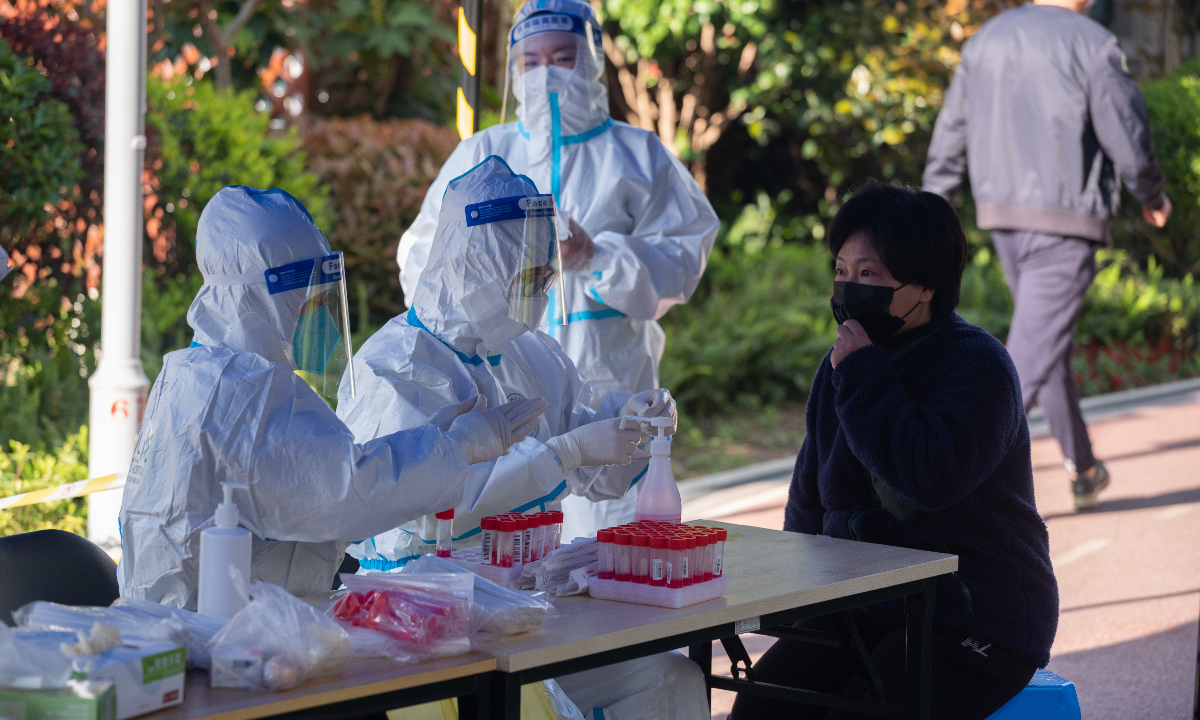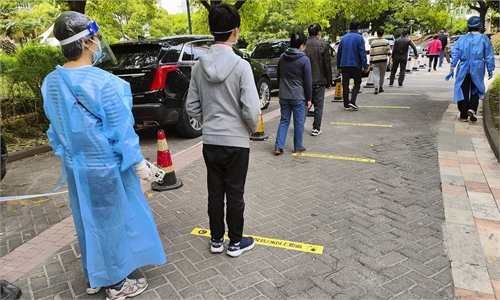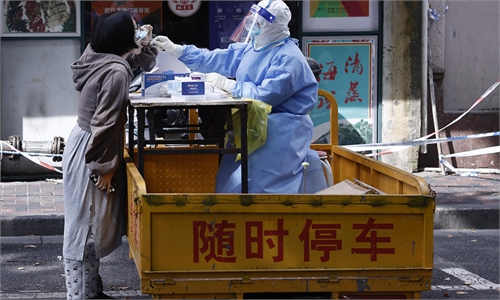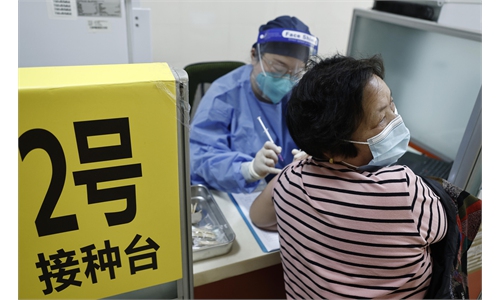Zero new infection outside quarantine for the first time in Shanghai but ‘guard cannot be let down for now’

A woman takes the nucleic acid test in Shanghai on April 4, 2022 Photo: VCG
Omicron variant-hit Shanghai reported zero new infections outside quarantine for the first time as the May Day holiday is approaching, indicating an initial achievement of zero community transmission in the combat against the epidemic, experts noted, stressing the guard cannot be let down for now and continuous tight control to be implemented at community level.
Shanghai continued to see declining new COVID-19 infections with 1,249 new confirmed local cases and 8,932 asymptomatic infections registered on Friday, according to Shanghai health authority.
Statistics show that all these confirmed cases and the asymptomatic carriers were discovered either in closed-loop management or already under medical treatment or observation.
It was noteworthy that it took the city five days to bring down new infections outside quarantine from 300 or so to 200, and two days from 200 to 100 and just one day from 100 to zero.
The epidemic prevention and control work in the city is still at a critical stage with the situation being grim and complex, thus the management and control at the community level still should be strengthened, Zhao Dandan, deputy director of Shanghai Municipal Heath Commission, announced at a press briefing on Saturday, urging the public not to relax or gather and reduce the flow of people to consolidate the hard-won achievements in epidemic prevention and control over the past month.
"The zero increase of new infection outside the quarantined areas is a good sign but we still need to wait a couple of more days to observe the development of the epidemic," a Beijing-based expert of immunology told the Global Times under anonymity on Saturday, noting that continuous zero increase is required to consolidate the achievements made in the combat against the virus and the vigilance cannot be lowered for now.
The Shanghai health authority also stressed continued strict implementation of the epidemic control requirements in the areas in lockdown, and under control and precaution, with the number of which in lockdown and under control continuing declining.
Compared with the statistics of Thursday, the population in lockdown and under control decreased by 830,000 and 540,000 respectively while the population in precaution area increased by 1.4 million, reaching 13.78 million. Shanghai has a population of over 25 million.
The immunology expert noted that the next step is to take decisive moves to narrow down the range of areas in lockdown and under control, meanwhile increasing the supplies of daily necessities for the local residents to improve their immunity to combat the virus since he is afraid that long-term lockdown can lead to insufficient nutrition supply.
Meanwhile, the city registered 47 more COVID-19 patent deaths on Friday, which took the city's death tally during the recent flare-up to 384 as of Friday.
The average age of the 47 deceased patients was 82.4 years old, and underlying conditions, including a series of diseases or tumors of multiple organs, were the immediate and direct causes of their deaths. Only three patients had been inoculated and the rest had never taken a jab.
Besides, a total of 356 patients of the serious type and 57 patients in critical conditions are being treated at designated hospitals as of Friday.
Zhao urged the elderly eligible for vaccination to take the jabs as soon as possible since vaccination plays an important role in enhancing protection of the elderly.
"With the recent declining figures, I am personally positive toward the coming of inflection point of the flare-up in Shanghai," Fang Bangjiang, expert leader of traditional Chinese medicine treatment at a makeshift hospital set up at the Shanghai New International Expo Centre, said during an interview with the Health Times under the People's Daily, noting that prevention and treatment of severe cases and reduction of death cases can be the focus of the next step in the fight against the epidemic in Shanghai. According to Fang, 30 percent of the hospitalized at present are in their 60s and 60 percent of them have underlying diseases.
According to Zhao, the cumulative local COVID-19 infections have exceeded 570,000 over the latest outbreak in the city which has rolled out a series of measures including promoting designated hospitals, expanding the scale of makeshift hospitals, and coordinating the municipal- and district-level medical forces, in line with the principle that all suspected and confirmed patients should be admitted to the hospital.
With 2,807 confirmed patients discharged from hospitals and 13,605 silent carriers released from centralized medical observation centers on Friday, a total of 131,030 infections have been cured and discharged from designated or makeshift hospitals over the past six days, Zhao said, noting that the demand and supply of ward beds at both designated and makeshift hospitals has reached a tight balance from the initial shortage.
As a part of the efforts to further consolidate the achievement of the epidemic prevention and control work and adapt to the changing situations, Shanghai will further lower the prices of nucleic acid tests, with the price for an individual's sample reduced to 25 yuan ($3.77) from 28 yuan at public hospitals starting May 1. Besides, nucleic acid testing service will be offered for free at the city's first batch of 534 regular sampling sites for the normalization of nucleic acid testing between May 1 and June 30.



